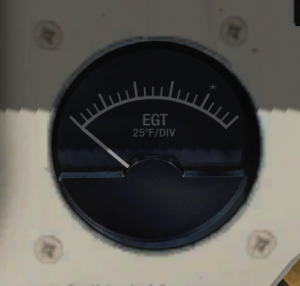This how-to is focused on mixture leaning. Correctly controlling the mixture is really important for both the health and the performance of our beloved engines.
The Reality Expansion Pack now cares about how you lean the mixture and how you manage the internal engine temperatures. This post is meant to provide the base knowlege you need to avoid any kind of issue while flying your favourite REP airplane in X-Plane.
I was going to write a very long post about CHTs, EGT, leaning etcetera, but actually, as you already know, the Internet is a great place.
There are literally thousands of resources about mixture leaning so I’ve decided to just collect them here.
But for those of you that are not yet tech-savy, let’s make a little preface.

Preface – EGT, ROP and LOP
There are different ways of leaning the mixture. One of the easiest is using and EGT indicator.
What is an EGT indicator? EGT stand for Exhaust Gas Temperature. The instrument we have in the cockpit is kind of a thermometer that indicate the temperature of the engine’s exhaust gas.
On the indicator scale you don’t see any number. Infact, you don’t really need to know what temperature it is reporting. All you need to know is that each small notch (division) over the scale indicates 25°F from the previous one. So, a large notch indicates 100°F over the previous large one.
The EGT, together with the CHT (Cylinder Head Temperature) is a useful indication of what is going on inside the engine.
Just view it like this: inside the engine you mix air with fuel. You need about fifteen parts of oxygen for each one of fuel to make the “perfect” combustion (where all the parts of fuel in the chamber are burned and no oxygen nor fuel are left after the combustion).
The 15:1 ratio is called stoichiometric ratio.
When you are flying at sea level and set mixture full rich, the ratio is lower than stoichiometric, let’s say 14:1. This means that some fuel will not burn. It will just cool down the cylinders, thus creating a certain EGT.
When you’re in flight and you slowly lean the mixture, you increase the ratio towards 15:1. As there is less fuel cooling down the engine, you see that the EGT indicator reports an increasing temperature. The more you lean, the higher the temperature.
At a certain point, the temperature peaks. That peak is the Peak EGT and you’re flying the engine at about the 15:1 ratio.
From there on, the EGT will drop as you continue leaning. This is because there is more air than fuel and the unburned air cools down the cylinders, generating a lower EGT.
Now ROP and LOP start meaning something.
ROP stands for Rich of Peak, that is, a richer mixture than the one you need to fly at peak EGT.
LOP stands for Lean of Peak, that is, a leaner mixture than the one you need to fly at peak EGT.
A rule of thumb
Now that we know what ROP and LOP mean, we can define a simple rule of thumb to avoid any issue during flight.
Let’s divide our “engine operations” in three parts basing on the percent of engine’s power output. To know at which percent of Maximum Continuous Power (MCP) you’re at, base your engine settings on the reference tables that you find in the checklists (both digital or printable) of your REP aircraft.
Very high power (more than 80% of MCP)
In this situation, the EGT is already high by itself. The engine is “under stress” so the less we lean the better for the engine.
Lean more than 60LOP or go richer than 200ROP.
High power (more than 75% of MCP)
The rule is do not lean between 180 ROP and 40 LOP.
If you go richer than 180ROP the engine will be cooled enough by the fuel. If you go more than 40LOP, the engine will be cooled down by air. In the middle of them you’re damaging the engine.
Going LOP, in this case, might degrade the engine performances a little bit too much for our tastes if we are doing and high performance climb but will save a lot of fuel.
Medium power (more than 70% of MCP)
Lean less than 25 LOP or go richer than 125ROP. The reasons are the same as above. The interval between the limits has just tightened because the engine internal pressure is lower than before.
Medium power (more than 65% of MCP)
Lean less than peak or go richer than 100ROP.
Low power (less than 65% of MCP)
You’re a free soul here. Lean how much you like. You’re not going to hurt anyone here!
Some useful resources about leaning
Now that you know the basics, you may want to go deeper and understand more of the leaning mechanics.
Here you find a list of articles that I find really interesting.
The Savvy Aviator
The bible: http://www.avweb.com/news/savvyaviator/savvy_aviator_59_egt_cht_and_leaning-198162-1.html
AOPA’s dogfight
This article describes with data, the pros and cons of ROP and LOP: https://www.aopa.org/news-and-media/all-news/2011/may/01/dogfight-running-lean-of-peak
EAA’s webinar about mixture leaning
To really understand modern times, we need to review the “hystory of leaning”.
Why were/are pilots so afraid of leaning? Why the POHs sometimes tell lies? Why now we know that the old tales were just tales?
The following video is from EAA Airventure and is really explicative and answers all the previous questions.
Beware. It’s flash only!
Now let’s make a test!
Did you really understood what mixture leaning involves?
The following quiz can be a good exercise before flying REP: http://studentpilotnews.com/2016/05/19/quiz-mixture-control/
Pay attention to question number 3 as none of the answers is really correct.
Comment on Facebook
Do you have questions about leaning? Write a comment on our FB group: https://www.facebook.com/groups/realityexpansionpack/

Pingback:REP for JustFlight Piper Turbo Arrow III/IV - SimCoders.com